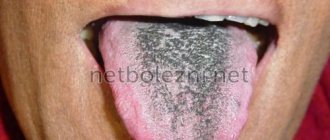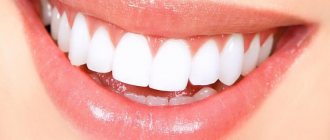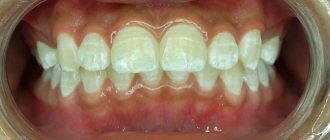Causes of blackening of teeth near the gums
The condition of tooth enamel is affected by various household factors, as well as systemic and dental diseases.
Household causes of darkening of the gum area include:
- frequent consumption of coffee, tea or red wine;
- smoking abuse;
- presence of natural juices (grape, tomato) in the diet;
- Let's take medications containing iron gluconate.
Coloring drinks and juices contribute to the appearance of dark pigmentation on the enamel, which is temporary and is removed after hygiene procedures.
Pathological processes that cause the formation of black plaque on the teeth near the gums:
- carious lesions;
- fluorosis is a disease associated with excess fluoride in the body;
- cervical caries;
- presence of tartar.
Cervical caries is one of the causes of dark spots
If the tooth turns black near the gum, this may be a symptom of the progression of cervical caries - a carious process localized in the cervical region.
Cervical caries is considered one of the most dangerous types of tooth damage, as it occurs in a latent form, affects tooth enamel in a vulnerable place and destroys it at an accelerated pace.
Pathology has a gradual development:
- The appearance of a pigmented spot in the neck of the tooth near the gum.
- Formation of a rough surface of the affected area.
- Increased sensitivity to external irritants - hot, sour, cold foods, pain.
- Change in color of the spot from light brown to black.
Deep cervical caries is characterized by significant destruction and is complicated by the development of pulpitis.
►►► Here! Read a detailed article about cervical caries and methods of treating this disease.
Why do children's teeth turn black?
Children's milk teeth are susceptible to carious lesions much more intensely than molars, since they do not have a dense structure. The enamel darkens due to the development of pathological processes in the oral cavity, which in children are provoked by:
- congenital fragility of enamel;
- calcium deficiency;
- irregular oral hygiene;
- vitamin deficiency;
- chipped teeth;
- endemic fluorosis;
- chronic diseases of the gastrointestinal tract;
- hereditary factor.
Nighttime bottle feeding is often considered the cause of blackening of teeth in children under 2 years of age. When drinking milk or formula at night, saliva production decreases. The acids formed on the teeth during feeding are not washed away naturally and start the process of destruction of the enamel.
If the tooth has darkened
If one tooth has darkened and this is not a superficial plaque, but a change in the color of the tooth enamel, this means that we are talking about the death of the dental nerve and damage to the pulp. Perhaps the nerve was killed or removed during dental treatment, or the patient was in no hurry to see a doctor during an acute inflammatory process that led to the death of the nerve. Be that as it may, if a tooth is blackened from the inside, it means that only intra-canal whitening, installation of a crown or veneer will help it. In this case, the dentist must first find out why the tooth turned black and rule out the inflammatory process.
As a rule, an experienced specialist, when treating a tooth with nerve removal, knows that it will change color and immediately advises the patient to think about installing a crown or veneer. Therefore, if you don’t know exactly why your tooth turns black, remember if your doctor warned you about the possibility of such consequences.
Sometimes the reason a patient goes to the dentist is that the tooth has turned black under the filling. In this case, the cause of the tooth discoloration is most likely due to poor quality treatment. In particular, the filling may turn black if blood gets into it during installation - for example, because the doctor injured the gum. Also, a tooth under a filling may turn black if the dentist has not completely removed the damaged tooth and the carious process continues under the filling. In this case, the filling will have to be removed and a new one installed. This is a good reason to think about the professionalism of the doctor who performed the dental treatment.
In any case, the first thing to do if a tooth has turned black is to contact a reliable, highly qualified dentist.
Professional dental care
Treatment of blackening of teeth near the gums in the dental office includes several stages:
- Elimination of the reasons that provoked the color change.
- Bleaching.
If the surface of the tooth near the gum has turned black due to the presence of cervical caries, measures must be taken to eliminate it. Treatment options for blackening will depend on the stage of enamel damage:
- At the black spot stage, remineralizing therapy is used: the tooth surface is cleaned of plaque and stone, and applications with fluoride-containing compounds are applied to the affected area.
- At the stage of superficial caries, the affected area is polished and eliminated.
- In case of average caries, the damaged part of the tooth is removed, the area is treated with a special preparation and a filling is installed.
- In case of deep caries, the pulp is removed and the canals are cleaned, after which a filling is installed.
If the tooth turns black at the gum due to tartar deposits, the affected areas are cleaned using one of the selected methods:
- mechanical – manual method using special tools;
- chemical - removal of solid deposits using compounds based on alkalis and acids;
- ultrasonic cleaning – devices that emit sound waves are used to clean enamel;
- laser – removal of tartar with a laser.
The teeth whitening procedure is the final stage of cleansing the enamel from darkened plaque. For this purpose use:
- laser installations;
- ultrasound;
- chemical compositions;
- special lamps.
How to remove black plaque from teeth?
Since it is impossible to remove black plaque from teeth at home, you must definitely contact a dental clinic. The first thing the doctor should do is interview the patient and find out the supposed cause of dark plaque on the teeth. Well, if it’s just a matter of love for coffee and cigarettes, then you can be sure that regular teeth cleaning using professional equipment will eliminate the problem. But what to do if your teeth turn black due to other reasons?
The doctor may recommend undergoing certain tests - and perhaps, in parallel with eliminating plaque, treat the cause that caused it. Or eliminate factors that could cause plaque formation. In any case, the cause of plaque must be determined as quickly as possible.
Cleaning teeth from mineralized plaque is usually done using ultrasound. This is the least traumatic method, which has already proven its effectiveness. That is why it is used in large dental clinics. If the reasons why teeth turn black are related to external factors, the doctor may advise further use of a special toothbrush and special pastes designed to combat this problem. Perhaps this will be enough to prevent the reappearance of black plaque on the teeth.
Drug treatment for darkening of teeth near the gums
What to do if the teeth near the gums turn black? Use local and systemic drugs to eliminate the problem, the choice of which depends on the reasons that provoked the development of the pathology.
Local treatment involves the use of remineralizing therapy, which includes the following drugs:
- Remodent is an anti-caries agent that replenishes calcium and fluoride deficiency. It is used in the form of solutions and applications (1 portion of the substance per 100 ml of water). A cotton swab is moistened in the resulting solution and applied to the affected area for 15–20 minutes. The procedure is carried out 2 times a week.
- A combination of calcium gluconate and sodium fluoride solutions.
To whiten teeth blackened due to smoking abuse, use:
- preparations in the form of gels containing carbamide peroxide;
- concentrated solution of hydrogen peroxide.
The duration of the course is 10–14 days.
Popular products for removing black plaque:
- Superoxol;
- Denta Lite Plus;
- Perfection White;
- Prema;
- Opalescence.
To eliminate dark spots in the gum area of non-carious origin (enamel erosion, fluorosis), the following are used:
- preparations with calcium gluconate in the form of applications every other day, 1 time per day;
- taking vitamins (retinol, thiamine, calcium lactate, phytin).
If blackening of the teeth near the gums provokes deep caries, the following is prescribed:
- Calcemin;
- Radoplast;
- Calcidonite.
How to restore natural color to teeth
It all depends on the causes of the pathology:
- If darkening of the teeth is a consequence of injury, it is necessary to remove the damaged tissue and fill the canals;
- If the cause is poor oral hygiene, the dentist will develop a comprehensive hygiene program that will need to be followed for at least several months;
- If the problem is caries, it should be removed, and then the damaged tissue should be restored;
- In other situations, hardware or home whitening can help.
Black teeth always spoil the aesthetics of a smile, but you can restore them to a healthy color. To do this, be sure to seek help from your dentist.
Folk remedies
If the tooth surface near the gums is black, you can use traditional medicine that has a whitening effect without the risk of damaging the enamel.
Effective recipes for use at home in the presence of dark plaque:
- 1 tsp. Mix baking soda and hydrogen peroxide in a separate container. Apply the prepared mixture to the neck of the tooth near the gum using a cotton pad. After the procedure, rinse your mouth with warm water.
Prolonged and frequent exposure to hydrogen peroxide can damage tooth enamel, so the procedure should be repeated no more than once a week.
- Mix 2 tsp. dried sage leaves and 2 tsp. sea salt. Place the resulting mixture on foil and dry in the oven at 180C for 20 minutes. Use ready-made teeth cleaning product.
- Grind 3 tablets of activated carbon into powder. Dip a damp toothbrush into the crushed preparation and brush your teeth for 2-3 minutes, paying special attention to the affected areas near the gums. Repeat the procedure 1-2 times a week.
Prevention of plaque
To prevent blackening of the enamel in the gum area, you need to follow simple rules for oral care:
- carry out hygiene procedures regularly;
- visit the dentist for timely sanitation of the oral cavity;
- lead a healthy lifestyle;
- eat a balanced diet;
- At the first signs of damage to tooth enamel, consult a doctor.
Blackness in the area of the neck of the tooth near the gum not only spoils the aesthetic appearance of the smile, but can also lead to the destruction of the enamel. To eliminate darkened stains, a set of measures has been developed, consisting of dental procedures and the use of medications, which is aimed at strengthening and whitening tooth enamel.
Bibliography
- Murovyannikova Zh.G. – Dental diseases and their prevention, Rostov n/a: Phoenix, 2011.
- Dmitrieva L.A. — Modern aspects of clinical periodontology, M., 2001.
- Yakovleva V.I. – Diagnosis, treatment and prevention of dental diseases, Minsk 1994.
- Borovsky E.V. and co-authors - Therapeutic dentistry, M. 1998.
- Borovsky E.V., Leus P.A. — Dental caries, M., Medicine, 1979.
- Pakhomov G.N. - Primary prevention in dentistry, M., Medicine, 1982.
- Ulitovsky S.B. — Encyclopedia of Preventive Dentistry, St. Petersburg, 2004.
- Kuryakina N.V. - Therapeutic dentistry of children, - Medicine, 2004.
Find a clinic
About black plaque
If black plaque appears on your teeth, know that this is not a disease, but only a consequence. If we are talking about a child’s teeth, then the cause may be taking antibiotics or improper functioning of the gastrointestinal tract. He may develop dysbiosis. The problem may also be that the child drinks too much apple juice. Or, when brushing his teeth, he uses adult toothpaste, which contains a lot of fluoride. In fact, there are many reasons why black plaque appears.
If we talk about adults, then the appearance of such plaque in them can be caused by several factors: excessive consumption of coffee and smoking tobacco.
The blackness does not go deep into the teeth, but the trouble is that it spoils their appearance. What does this lead to? Obviously, to an inferiority complex, because a person simply loses all self-confidence. Often he simply withdraws into himself, which spoils his relationships with the people around him. What's the result? Lifestyle changes, loss of spirit, and various depressions.
It is very difficult to clean your teeth from black plaque on your own. Traditional cleaning methods (such as using a toothbrush) cannot bring any effect. And the only way out of this situation is to consult a dentist. Unfortunately, there is a certain danger here. The fact is that many people want to find cheaper dentist services. They say, why overpay for such a procedure? And finding such clinics is not difficult. Many dentists will chemically whiten your teeth for little money.
But the fact is that the result may not please you. Firstly, because dry cleaning only gives a temporary effect and will even harm your teeth. Chemical whitening also destroys the protective enamel layer of the tooth. The enamel ceases to be hard and becomes loose. And as soon as you eat some coloring food (like beets), your teeth will immediately lose their snow-white appearance. Unfortunately, mechanically durable snow-white cannot be achieved. Cheap treatment will give cheap results: the stingy pays twice.
A good effect can only be achieved using a laser. In this case, the laser procedure must be performed by a professional dentist. For example, doctors of the French Dental Clinic, who have not only excellent education, but also personal treatment methods.
Healthy teeth and good health
FDC will be a pleasant find for you and your family on the path to impeccable aesthetics and good health.
Our doctors approach any patient’s problem with particular scrupulousness. Before treatment begins, each person is examined to identify the disease. The objectives of the study also include identifying the unique characteristics of the oral cavity of a particular person. Next, a decision is made about which treatment will be most successful for the patient.
To begin with, the black deposits are removed using professional cleaning tools. Bacteria and tartar are removed. Next, the dentist applies a special gel to the tooth and begins working with the laser. The beam works in pulses, as a result the tooth does not heat up. The laser acts on the gel and introduces oxygen deep into the tooth, thereby brightening the latter. This procedure will not cause any pain. And the snow-whiteness will be stable and will remain for many years. In addition, this procedure has a beneficial effect on tooth enamel.
After the procedure, you will sometimes need to visit the dentist for preventive maintenance. The earlier the disease is found, the cheaper and easier it will be to cure.










